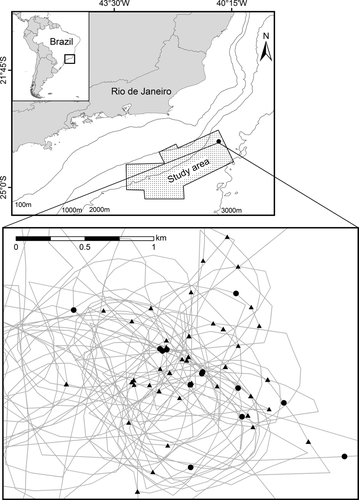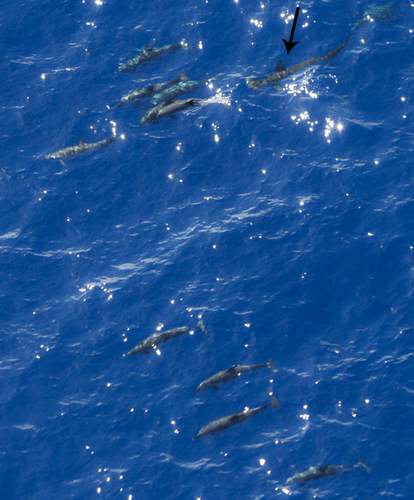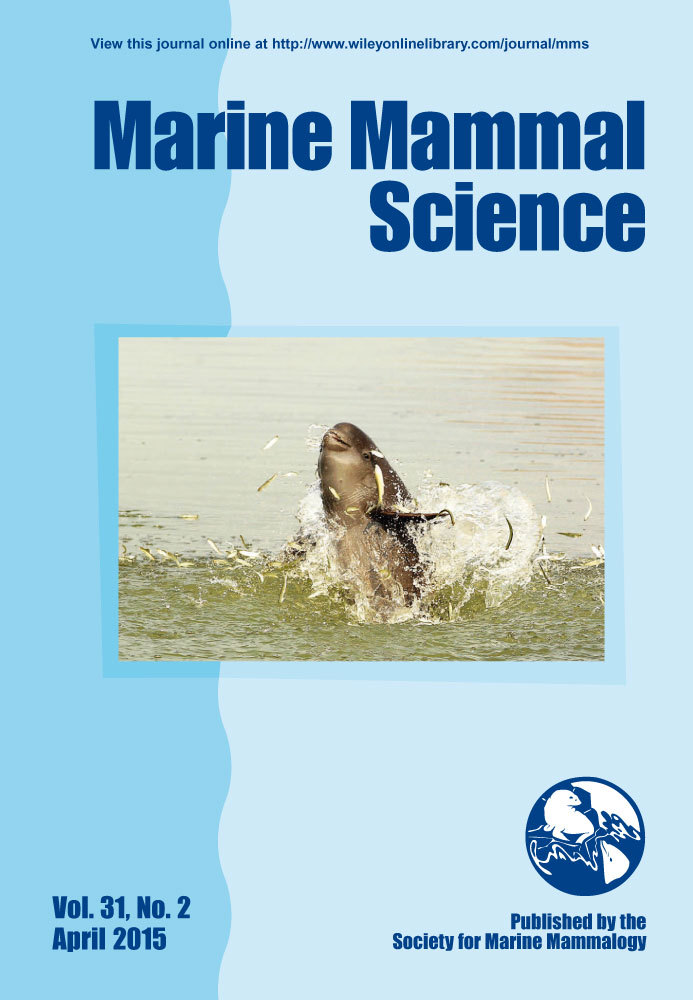Observations of antipredator tactics among pantropical spotted dolphins (Stenella attenuata) attacked by smooth hammerhead sharks (Sphyrna zygaena)
Sharks are known to prey upon many odontocete species worldwide (reviewed by Heithaus 2001). Predation risk has been considered as the primary factor leading to the evolution of group living in dolphins (Wood et al. 1970, Norris and Dohl 1980, Connor 2000, Heithaus 2001). Large schools of pelagic dolphins in open ocean likely reflect high risk of predation (Saayman et al. 1972, Norris and Dohl 1980, Connor 2000), but few data have been collected regarding this issue. Direct observations of sharks attacking cetaceans in the wild are rarely reported (but see Mann and Barnett 1999, Connor 2000, Maldini 2003, Turnbull and Dion 2012), and the strategies that dolphins use to avoid predation are very poorly studied (Gowans et al. 2008).
The ecology of pantropical spotted dolphins (Stenella attenuata) in the southwest Atlantic Ocean is still poorly understood (Perrin 2001). The distribution of this species in the southwest Atlantic Ocean extends south to 23°S, and groups of 3–250 dolphins have been recorded over depths ranging from 850 to 4,900 m (Moreno et al. 2005). Sexually mature pantropical spotted dolphins range in size from 166 to 257 cm, with a wide geographic variation (Perrin 2009). These dolphins can form distinct and relatively stable subgroups within schools, which may contain cow-calf pairs, adult males, or juveniles (Pryor and Shallenberger 1995). Discrete small schools of juveniles tend to occur separated from large schools of breeding adults and nursing calves (Perrin 2001).
Five species of sharks are relatively frequent predators on dolphins and porpoises: white (Carcharodon carcharias), bull (Carcharhinus leucas), tiger (Galeocerdo cuvier), sixgill (Hexanchus griseus), and sevengill (Notorynchus cepedianus) sharks. Although hammerhead sharks (Sphyrna spp.) attain sizes that may be capable of preying upon small odontocetes, few reports exist of attacks on free-swimming dolphins (Heithaus 2001). The smooth hammerhead shark (Sphyrna zygaena) is one of the most commonly captured shark species in commercial fisheries in the pelagic waters of Brazil (Kotas et al. 2005). Shallow waters of the continental shelf are utilized as breeding and nursery grounds, while adults form large schools in deep offshore waters (Kotas et al. 2005, Vooren et al. 2005). There is little information about the trophic ecology of smooth hammerhead sharks in Brazilian waters and there is no published evidence for predation on cetaceans elsewhere (Heithaus 2001, Vooren et al. 2005, Bornatowski et al. 2007, Bornatowski and Schwingel 2009). Here, we describe an attack by smooth hammerhead sharks on a group of pantropical spotted dolphins in pelagic waters off Brazil, and discuss some aspects of group antipredation tactics.
The attack was observed during an aerial survey for cetaceans in the Santos Basin, southeast Brazil. Aerial surveys followed line transect methodology (Buckland et al. 2001). Surveys were carried out between 13 March and 12 May 2012 searching a total of 13,616 km over depths of 100–3,000 m (Fig. 1). Visual surveys were made from a high-wing, twin-engine Aerocommander 500-B aircraft flying at an altitude of 150 m and a speed of 170–190 km/h. The aircraft had four observation positions (two on each side of the plane) with bubble and flat windows for front and rear observers, respectively. The survey team consisted of four observers, who worked independently, with no communication with each other during the flights. Environmental conditions (Beaufort sea state, water transparency, and a subjective assessment of overall conditions) and sighting data (declination angle to the sighting when it was abeam, species, group size, and behavior) were recorded on audio digital recorders. All data (audio and photos) were time-referenced based on digital watches synchronized to a GPS allowing georeferencing.

On 10 May 2012 at 1122, a group of about 100 pantropical spotted dolphins was sighted being pursued by at least three smooth hammerhead sharks, estimated to be between 3.0 and 3.5 m total length, in waters 2,400 m deep and 168 km offshore of Rio de Janeiro (23°51′36″S, 40°50′24″W) (Fig. 1). After detection of the shark-dolphin interaction, the aircraft circled back to overfly the group and take photos (Fig. 1). Two observers took photos while the other two recorded ad libitum behavioral observations (Altmann 1974). The sighting conditions were good with a Beaufort sea state of 2 and water transparency estimated to be at least 5 m deep allowing a good view of submerged animals. The dolphin species was identified based on the strongly defined cape passing over the eye, a flipper stripe terminating anteriorly at the angle of gape, no spinal blaze, and white distal ends of rostrum and lower jaw (Perrin 2001, 2009). The sharks were identified, based on photographs, by the shark specialist Dr. Otto B. F. Gadig (Elasmobranch Research Laboratory, Universidade Estadual Paulista–UNESP), and species determination was based on its very broadly arched head with no medial indentation (Compagno 1984).
During the sighting, the dolphin group was spread in subgroups varying in size and composition. A subgroup was defined using a 10 m chain rule (Smolker et al. 1992). A dolphin was considered part of a subgroup if it was within 10 m of any other member. Two types of subgroups were recorded: AO, adults-only and AC, adults with calves. Because of the speed of the aircraft the same subgroup could be detected more than one time during the aircraft circling, so assumptions about dolphin swimming speed were made to distinguish subgroups. Following the method proposed by Carretta et al. (1998), two subgroups were considered unique if the distance between them would have required the dolphins exceed an assumed maximum dolphin swimming speed between the time of the two detections. Distances between subgroups were calculated using the Posdist function of the Microsoft Excel add-in geofunc (http://www.afsc.noaa.gov/nmml/software/excelgeo.php), and the pantropical spotted dolphin's burst swimming speed of about 22 km/h (Perrin 2009) was used as maximum dolphin swimming speed. The sighting time (38 min) was divided into intervals of 2 min and, following the method described above, distances were calculated between distinguished subgroups within each interval. A Kruskal-Wallis test was used to determine if distances between AC and AO subgroups differed between time intervals. A linear regression model was applied to investigate the relationship between distances from adult dolphins under pursuit by sharks to other AO subgroups and time intervals. Distances were log-transformed in order to approximate a normal distribution. From all detected subgroups (n = 34), mean subgroup size for AC (mean ± SD = 12.1 ± 5.2) was significantly higher than for AO subgroups (7.6 ± 3.7) (Mann Whitney-U test, P = 0.028). The number of dolphins in AO subgroups when sharks were sighted near them was significantly higher than when no sharks were sighted (Mann Whitney-U test, P = 0.002). Sharks were never observed close to AC subgroups. Distances between AC and AO subgroups were not significantly different between time intervals (Kruskal-Wallis P = 0.359, 5 df). The linear regression of distances between adults under pursuit by sharks and other AO subgroups against time intervals produced a significantly positive slope (t = 2.289, P = 0.035) (Fig. 2).

Adult dolphins pursued by sharks exhibited different behaviors than those that were not pursued. When pursued, adult dolphins swam closer together and were just in front of the shark while other dolphins were swimming nearby. Individuals were observed making evasive maneuvers and appeared to be moving rapidly based on water disturbance (Fig. 3). Dolphins that were not being pursued appeared to be swimming slowly and were not observed forming tight groups.

At 1152 two smooth hammerhead sharks were seen approaching a solitary and static pantropical spotted dolphin. Although it was not possible to observe an attack, when the aircraft circled back to the point a bloodstain was spotted on the sea surface suggesting that the sharks had successfully attacked the dolphin. This area was overflown for 10 min but neither dolphins nor sharks were sighted again.
In the open ocean the only effective antipredatory strategy may be to form groups (Gowans et al. 2008). Under attack, dolphins in a group decrease their chance of being preyed upon through predator confusion, and through dilution (Connor 2000). These benefits of grouping could explain the larger size of the vulnerable AC subgroups, as well as the increased number of dolphins in AO subgroups when sharks were in view near them. Norris and Schildt (1988) suggested that closer spacing between dolphins allow individuals to detect more subtle responses in their neighbor, and thus respond more quickly to threats. The observation of adult dolphins observed swimming in tight groups just in front of the shark is consistent with this hypothesis.
It is somewhat surprising that during the 38 min of observations, no sharks were sighted in close proximity to subgroups with calves since sharks are expected to target smaller and slower individuals. Dolphins of different age/sex classes may respond differently to predation risk (Heithaus 2001). The increasing average distance between adults under pursuit by sharks and other AO subgroups over the observation period (Fig. 2) indicates that faster swimming adults could flee from the attack area. Nevertheless, the larger AC subgroup size suggests that some adults remain with mother-calf pairs, even if this decision implies the individual not increase their distance from the potential predator due to the slower swimming of calves. Indeed, AO subgroups did not increase their distances to AC subgroups over the period. Other odontocetes are known to actively defend young group members. For example, protection of calves has been suggested to influence the behavior of all members of a sperm whale (Physeter macrocephalus) group, and may be an evolutionary force driving sperm whale sociality (Whitehead 2003).
Certainly, the high speed of the aerial platform preclude definitive conclusions regarding this interaction. Nevertheless, the data on group composition, behavior, and the spatial-temporal dynamics of the dolphins allow us to pose some hypotheses and suggest the following scenario. While some adult dolphins decided to flee from predation, as evidenced by their greater distance from sharks over time, others remained near the predation site. We hypothesize that this decision is driven by the motivation to offer protection to the slower mother-calf pairs by increasing their subgroup size and/or perhaps distracting the shark forming smaller, tighter AO subgroups near them. Given the fact that the sharks decided not to pursue AC subgroups but rather smaller AO subgroups suggest that the predator may have avoided larger dolphin subgroups or that somehow AO subgroups attracted the sharks' attention.
Although shark species regularly forage solitarily, aggregations of feeding sharks are also observed (Motta 2004). The role of the three smooth hammerhead sharks during the attack (mutual attraction to prey resource or cooperation, Heithaus 2004) is not clear. Stomach content studies indicate that hammerhead sharks appear to rarely include dolphins in their diets (Compagno 1984, Praderi 1985, Vooren et al. 2005). Our observations suggest that they are, however, potential predators and should be treated as such based on the behavior of the dolphins. Predation does not need to be frequent to induce considerable changes in behavior (Heithaus 2001, Heithaus and Dill 2006) so hammerheads could be important in shaping behavior of pelagic dolphins. Moreover, hammerhead sharks (S. lewini and S. zygaena) are among the most captured shark species in Brazilian pelagic waters (Kotas et al. 2005) so dolphin-hammerhead interactions could be more frequent than previously supposed.
Acknowledgments
This study was supported financially by NAV oceanografia. We are grateful to Otto Bismarck Fazzano Gadig (Unesp/CLP) for the identification of the shark species. We thank Michael R. Heithaus, Paulo Simões-Lopes, Daryl J. Boness, and three anonymous reviewers for their valuable comments, which improved the manuscript considerably. We also thank the pilots Cristiano Camejo and Alexandre Helm from JAD Taxi Aéreo for safely completing the aerial surveys.




